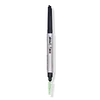What's inside
What's inside
 Key Ingredients
Key Ingredients

 Benefits
Benefits

 Concerns
Concerns

 Ingredients Side-by-side
Ingredients Side-by-side

Water
Skin ConditioningButylene Glycol
HumectantMethyl Trimethicone
Skin ConditioningAcrylates Copolymer
Stearic Acid
CleansingPolyglyceryl-2 Triisostearate
EmulsifyingPalmitic Acid
EmollientCeresin
Emulsion StabilisingSynthetic Beeswax
Emulsion StabilisingSynthetic Wax
AbrasiveHydrogenated Coco-Glycerides
EmollientPolysorbate 60
EmulsifyingCaprylyl Glycol
EmollientGlycerin
Humectant1,2-Hexanediol
Skin ConditioningPhenoxyethanol
PreservativeBentonite
AbsorbentPotassium Sorbate
PreservativeHydroxyethylcellulose
Emulsion StabilisingPvp
Emulsion StabilisingSodium Benzoate
MaskingTromethamine
BufferingAlcohol
AntimicrobialEthylhexylglycerin
Skin ConditioningSodium Dehydroacetate
PreservativeIron Oxides
CI 77891
Cosmetic ColorantC12-15 Alkyl Ethylhexanoate
EmollientPolyethylene
AbrasiveTrimethylsiloxysilicate
EmollientPolyisobutene
Water, Butylene Glycol, Methyl Trimethicone, Acrylates Copolymer, Stearic Acid, Polyglyceryl-2 Triisostearate, Palmitic Acid, Ceresin, Synthetic Beeswax, Synthetic Wax, Hydrogenated Coco-Glycerides, Polysorbate 60, Caprylyl Glycol, Glycerin, 1,2-Hexanediol, Phenoxyethanol, Bentonite, Potassium Sorbate, Hydroxyethylcellulose, Pvp, Sodium Benzoate, Tromethamine, Alcohol, Ethylhexylglycerin, Sodium Dehydroacetate, Iron Oxides, CI 77891, C12-15 Alkyl Ethylhexanoate, Polyethylene, Trimethylsiloxysilicate, Polyisobutene
Ingredients Explained
These ingredients are found in both products.
Ingredients higher up in an ingredient list are typically present in a larger amount.
Caprylyl Glycol is a humectant and emollient, meaning it attracts and preserves moisture.
It is a common ingredient in many products, especially those designed to hydrate skin. The primary benefits are retaining moisture, skin softening, and promoting a healthy skin barrier.
Though Caprylyl Glycol is an alcohol derived from fatty acids, it is not the kind that can dry out skin.
This ingredient is also used as a preservative to extend the life of products. It has slight antimicrobial properties.
Learn more about Caprylyl GlycolCeresin is a wax derived from ozokerite. It is an alternative to beeswax.
The most common process of creating ceresin is by using heat and sulfuric acid.
Methyl Trimethicone is a type of silicone. It is a solvent and emulsifier.
Solvents are used to keep ingredients together in a product. They can help dissolve ingredients to stable bases or help evenly distribute ingredients throughout the product.
Emulsifiers help stabilize a product. It does this by preventing certain ingredients from separating.
Methyl Trimethicone does not get absorbed into the skin.
Learn more about Methyl TrimethiconeStearic Acid is a fatty acid. It is an emollient, emulsifier, and texture enhancer.
As an emollient, stearic acid helps soften skin. It aids the skin's protective barrier by preventing water loss. It also provides a gentle cleansing effect without stripping away natural oils.
Stearic acid may also be used to enhance the texture of products. It can add volume and stabilize ingredients such as water and oil. This can help water and oil ingredients from separating.
Sources of stearic acid include animal or vegetable fats/oils such as coconut or shea. It can be naturally found in butter, cocoa butter, shea butter, vegetable fats, and animal tallow.
This ingredient may not be Malassezia folliculitis, or fungal-acne safe.
Learn more about Stearic AcidSynthetic beeswax is created to be identical in structure to beeswax. It possesses the same occlusive and emulsion properties.
A blend of fatty acid esters, fatty acids, and alcohols are used to create synthetic beeswax. Whether or not this ingredient is vegan depends on the source. Sometimes, lanolin is used for its creation.
This ingredient may not be Malassezia folliculitis, or fungal-acne safe.
Learn more about Synthetic BeeswaxSynthetic Wax is created from fossil fuels such as natural gas. It is used to enhance texture, adjust pH, and as an occlusive.
It may also be used as an abrasive ingredient to exfoliate the skin.
Synthetic Wax may not be fungal acne safe.
Learn more about Synthetic WaxThis silicone is an emollient. Emollients create a thin film on the skin to prevent moisture from escaping.
It is not soluble in water and helps increase water-resistance in products.
According to a manufacturer, it can blend seamlessly with silicone oils, such as Cyclopentasiloxane.
Learn more about Trimethylsiloxysilicate